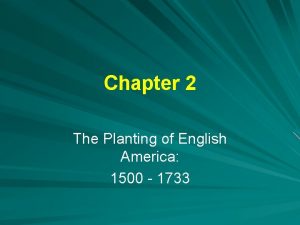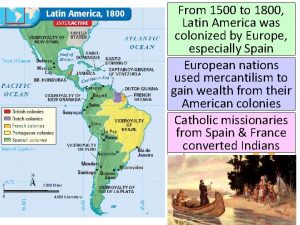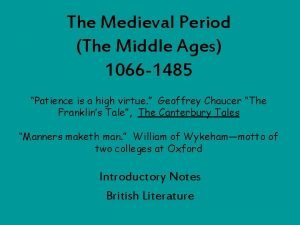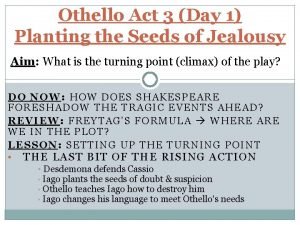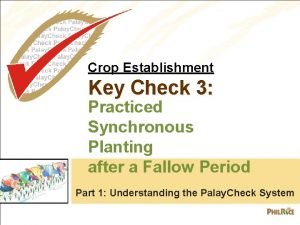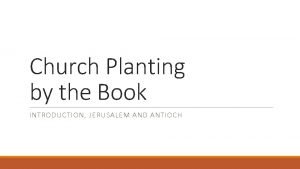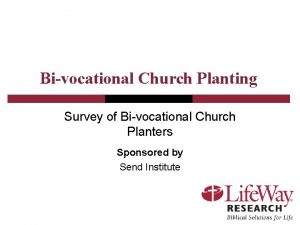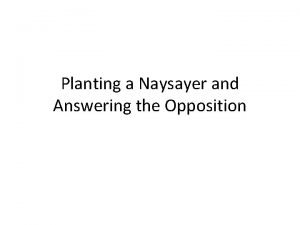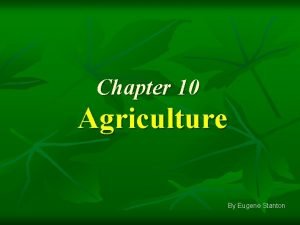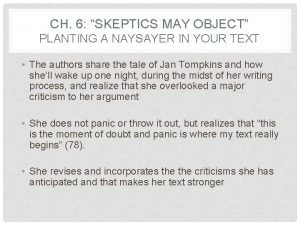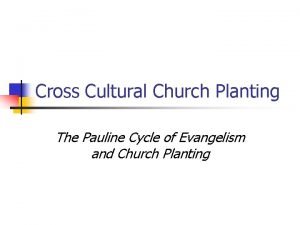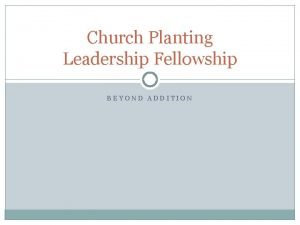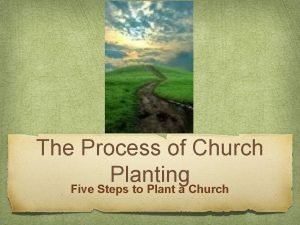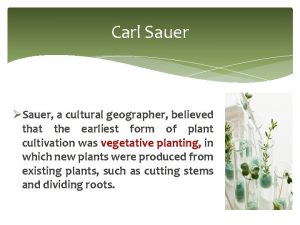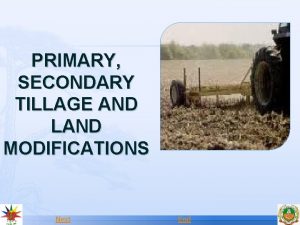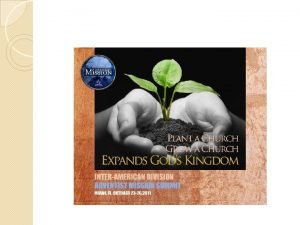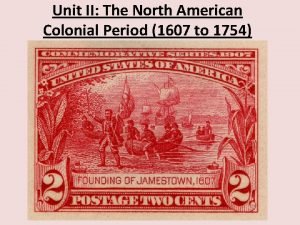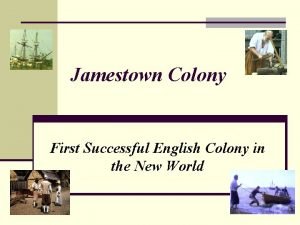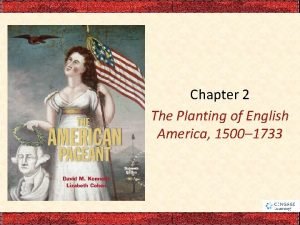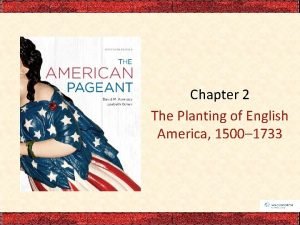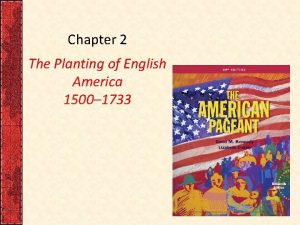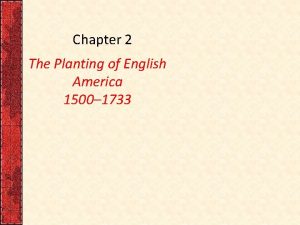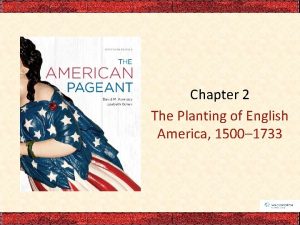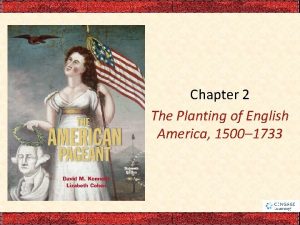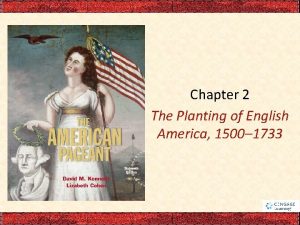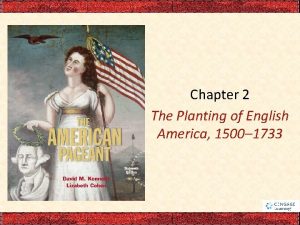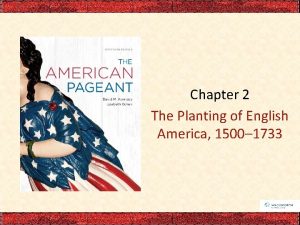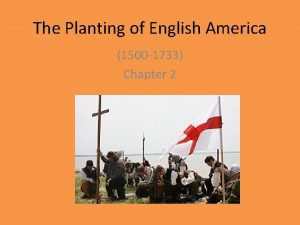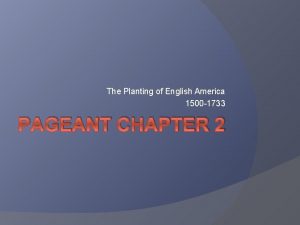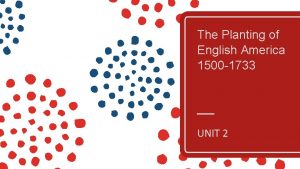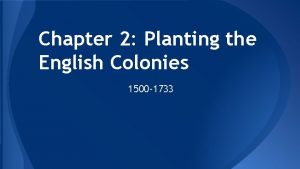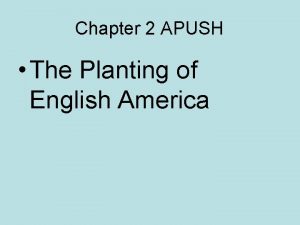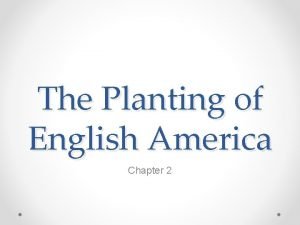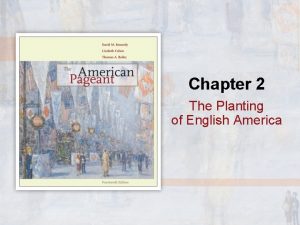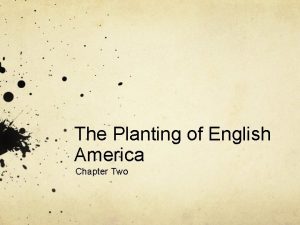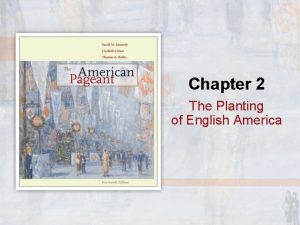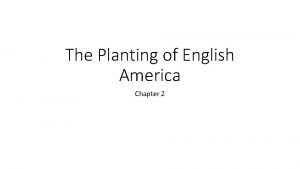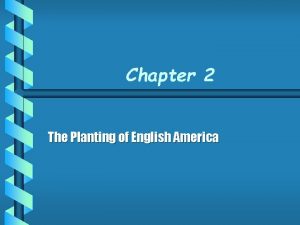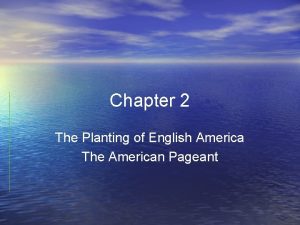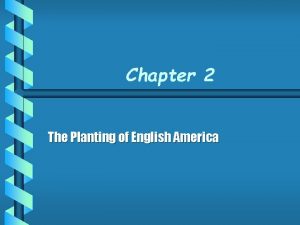Chapter 2 The Planting of English America 1500


















































- Slides: 50

Chapter 2 The Planting of English America 1500– 1733

I. England’s Imperial Stirrings • What events made England safe enough to start become a world power?

I. England’s Imperial Stirrings • In the 1500 s England made feeble efforts to develop overseas colonies. • In the 1530 s Henry VIII broke with the Roman Catholic Church, launching the English Protestant Reformation. • In 1558 Henry’s daughter, the Protestant Elizabeth I, became queen and established Protestantism in England.

I. England’s Imperial Stirrings (cont. ) • Catholic Ireland sought Catholic Spain’s help to throw off the new Protestant English queen. • Spanish aid amounted to little, and in the 1570 s– 1580 s Elizabeth’s troops crushed the Irish uprising. • English soldiers developed a sneering contempt for the “savage” natives, an attitude they took to the New World.

II. Elizabeth Energizes England • How important was Elizabeth I to England’s expansion into the world?

II. Elizabeth Energizes England • In 1577 English semipiratical “sea dogs” under Sir Francis Drake circumnavigated the globe. • The first English attempt at colonization was off the coast of Newfoundland. • In 1585 Sir Walter Raleigh landed on North Carolina’s Roanoke Island. • Virginia was named in honor of Elizabeth, the “Virgin Queen. ”

II. Elizabeth Energizes England (cont. ) • In 1588 England defeated the Spanish Armada, marking the end of Spain’s imperial dreams. • After victory, the English started to become masters of the world oceans—with important consequences for the American people. • England had strong national characteristics.

Table 2. 1 p 26

p 26

III. England on the Eve of Empire • What developments allowed England to fund and support imperialism.

III. England on the Eve of Empire • England experienced strong economic and social changes and a “surplus population. ” • Laws of primogeniture meant that only eldest sons were eligible to inherit landed estates. • By the early 1600 s, the joint-stock company was perfected. • Peace with Spain provided the opportunity for English colonization.

p 28

IV. England Plants the Jamestown Seedling • What were the beginnings and impact of the Jamestown Colony?

IV. England Plants the Jamestown Seedling • 1603: James I became king of England. • 1606: Virginia Company of London received a charter to settle in the New World. • This charter is significant; guaranteed settlers the same rights as Englishmen. • On May 24, 1607, the Virginia colony of Jamestown was founded (see Map 2. 1). • John Smith was key to the colony’s survival.

Map 2. 1 p 29

p 29

V. Cultural Clashes in the Chesapeake • In 1607 Chieftain Powhatan dominated the James River area. • In 1610 Lord De La Warr arrived from England with orders to deal with the Indians. • In 1614 the First Anglo-Powhatan War ended, sealed by Pocahontas’s marriage to colonist John Rolfe—the first known interracial union in Virginia.

V. Cultural Clashes in the Chesapeake (cont. ) • Second Anglo-Powhatan War (1644) was Indians’ last attempt to dislodge Virginians. • The Powhatans’ misfortune was the three Ds: disease, disorganization, and disposability. • “Powhatan’s Confederacy” lacked unity to oppose the disciplined whites. • The Powhatans served no economic function for colonists.

VI. The Indians’ New World • How did life change for the native-Americans impacted by Anglo colonization?

VI. The Indians’ New World • Indigenous people’s destinies had changed. • The shock of large-scale European colonization disrupted Native American life. • Horses, diseases, trade, and the expanding Atlantic economy transformed Indian life. • A new middle ground compelled both Europeans and Native Americans to accommodate each other.

VII. Virginia: Child of Tobacco • How important was tobacco to early colonial development? Explain.

VII. Virginia: Child of Tobacco • In 1612 John Rolfe perfected tobacco culture. • Virginia’s prosperity was built on this “bewitching weed, ” but King Nicotine depleted the soil. • Besides land, tobacco required lots of labor. • In 1619 a Dutch warship landed at Jamestown and sold some twenty Africans, planting the seeds of North American slavery.

p 32

VII. Virginia: Child of Tobacco (cont. ) • In 1619 representative self-government was born in primitive Virginia. • The House of Burgesses was an assembly or miniature parliament in the New World. • James I grew increasingly hostile to Virginia. • In 1624 he revoked the company’s charter and Virginia became a royal colony.

VIII. Maryland: Catholic Haven • What social issues created the Maryland colony?

VIII. Maryland: Catholic Haven • 1634: Maryland, 2 nd plantation colony, was founded by Lord Baltimore partly as a refuge for Catholics. • Resentment between Catholics and Protestants flared into open rebellion. • The Baltimore family for a time lost its proprietary rights, but the colony prospered. • As in Virginia, indentured servants initially provided labor for the tobacco economy.

VIII. Maryland: Catholic Haven (cont. ) • Lord Baltimore permitted unusual freedom of worship at the outset. • In 1649 the local assembly passed the famed Act of Toleration guaranteeing toleration to all Christians. • However, it decreed the death penalty for Jews and atheists, who denied the divinity of Jesus.

IX. The West Indies: Way Station to Mainland America • England secured claims to several West Indian islands, including Jamaica in 1655. • Their economy was based on sugar. • Had different requirements than tobacco. • Many enslaved Africans were imported to work the sugar plantations. • Black slaves eventually outnumbered white settlers.

p 34

p 34

IX. The West Indies: Way Station to Mainland America (cont. ) • 1661: Barbados slave code defined slaves’ legal status and their masters’ prerogatives. • Profitable sugar plantations crowded out most other forms of Caribbean agriculture. • 1670: Displaced settlers from Barbados arrived in Carolina with their slaves. • 1696: Carolina adopted the Barbados slave code, which eventually shaped slave laws throughout the mainland.

X. Colonizing the Carolinas • What spurred the development of the Carolina colony?

X. Colonizing the Carolinas • In the 1640 s civil war convulsed England. • After 1660 empire building resumed during the Restoration period (see Table 2. 2). • In 1670 Carolina was created, and it formed close links with the English West Indies. • Rice emerged as its principal export crop. • Charles Town was busiest seaport in South; Carolina survived Spanish and Indian attacks.

Carolina Indians German painter Philip Georg Friedrich von Reck drew these Yuchi Indians in the 1730 s. The blanket and rifle show that trade with the English settlers had already begun to transform Native American culture. p 31

p 30

Table 2. 2 p 35

XI. The Emergence of North Carolina • What made North Carolina distinctive from South Carolina?

XI. The Emergence of North Carolina • North Carolina has been called “the quintessence of Virginia’s discontent. ” • “Squatters” (newcomers without legal rights to the soil) raised crops on small farms. • Distinctive traits developed. • In 1712 North Carolina officially separated from South Carolina (see Map 2. 2).

Map 2. 2 p 36

XI. The Emergence of North Carolina (cont. ) • North Carolina shared with tiny Rhode Island several distinctions: – Most democratic – Most independent-minded – Least aristocratic of original thirteen English colonies

XI. The Emergence of North Carolina (cont. ) • Relations between Indians and Europeans were bloody: – 1711– 1713: Tuscarora War. – Displaced, the Tuscaroras later became the Sixth Nation of the Iroquois Confederacy. – After war with the Yamasee Indians in South Carolina (1715– 1716), most coastal tribes were devastated. • But tribes in the interior remained strong.

XII. Late-Coming Georgia: The Buffer Colony • What was the special nature of the Georgia Colony?

XII. Late-Coming Georgia: The Buffer Colony • In 1733 Georgia was founded as a buffer to protect the Carolinas especially from Spanish Florida. • It was named in honor of King George II of England. • Launched by a group of philanthropists, it would also serve as a haven for debtors. • Georgia was called “the Charity Colony. ”

XII. Late-Coming Georgia: The Buffer Colony (cont. ) • Georgia founders wanted no slavery. • James Oglethorpe, a key founder, helped ensure the colony’s survival. • Savannah, like Charleston, became a melting -pot community. • John Wesley served as a missionary. • Georgia grew more slowly than other colonies.

XIII. The Plantation Colonies • What made the colonies in South distinctively similar?

XIII. The Plantation Colonies • England’s southern mainland colonies shared: – Devotion to exporting agricultural products, mainly tobacco and rice – Slavery – Slow growth of cities – Religious toleration – A tendency to expand

Map 2. 3 p 38

p 38

p 39

p 40
 The planting of english america
The planting of english america Latin america 1500 to 1800
Latin america 1500 to 1800 America africa and europe before 1500
America africa and europe before 1500 North america, family histories, 1500-2000
North america, family histories, 1500-2000 Medieval time
Medieval time We can do a rap of the map of the us
We can do a rap of the map of the us Asia africa song
Asia africa song Repetition in let america be america again
Repetition in let america be america again Why called latin america
Why called latin america Happening body art
Happening body art How does iago plant the seed of jealousy in othello?
How does iago plant the seed of jealousy in othello? Foreshadowing in othello
Foreshadowing in othello Synchronous planting is an example of what control
Synchronous planting is an example of what control Introduction to church planting
Introduction to church planting Bivocational church planting
Bivocational church planting Objectives of planting flowers
Objectives of planting flowers Precisiondefinition
Precisiondefinition Crop hearths map
Crop hearths map Examples of naysayers
Examples of naysayers Nets church planting
Nets church planting Types of agriculture map
Types of agriculture map How to plant a naysayer
How to plant a naysayer Planting media
Planting media Pauline cycle of church planting
Pauline cycle of church planting Church planting leadership fellowship
Church planting leadership fellowship Planting a naysayer in your text
Planting a naysayer in your text Steps to planting a church
Steps to planting a church Carl sauer theory
Carl sauer theory Trees
Trees Tree planting
Tree planting Crop planting
Crop planting Types of tillage
Types of tillage Pow tree example
Pow tree example Iago jealousy quotes
Iago jealousy quotes Planting zones arizona
Planting zones arizona Nexus church planting
Nexus church planting Seedsense cap
Seedsense cap Precision planting graphite powder
Precision planting graphite powder 300000/260
300000/260 What was the first successful english colony
What was the first successful english colony What was the first successful english colony
What was the first successful english colony Hình ảnh bộ gõ cơ thể búng tay
Hình ảnh bộ gõ cơ thể búng tay Ng-html
Ng-html Bổ thể
Bổ thể Tỉ lệ cơ thể trẻ em
Tỉ lệ cơ thể trẻ em Chó sói
Chó sói Chụp tư thế worms-breton
Chụp tư thế worms-breton Hát lên người ơi alleluia
Hát lên người ơi alleluia Các môn thể thao bắt đầu bằng tiếng chạy
Các môn thể thao bắt đầu bằng tiếng chạy Thế nào là hệ số cao nhất
Thế nào là hệ số cao nhất Các châu lục và đại dương trên thế giới
Các châu lục và đại dương trên thế giới
